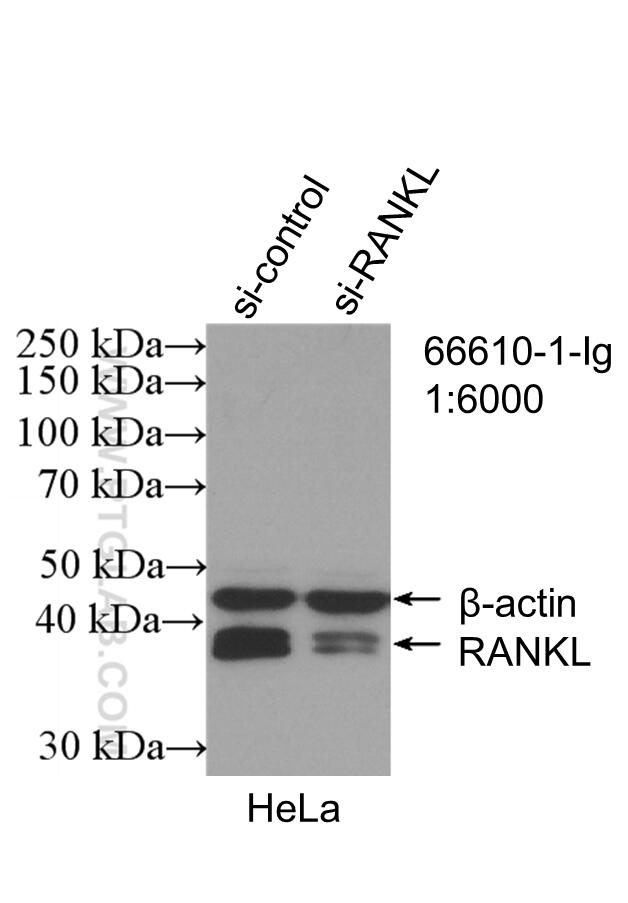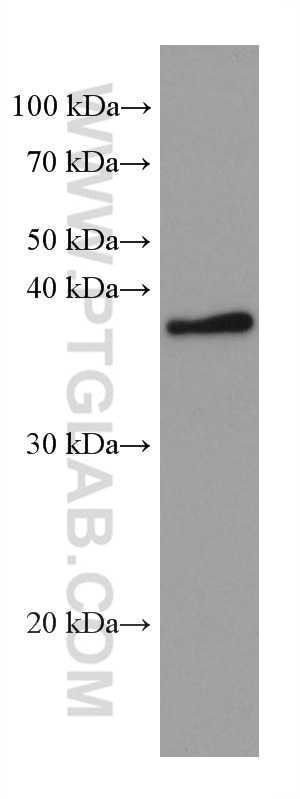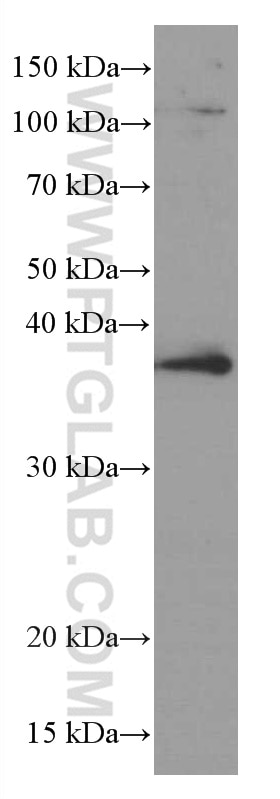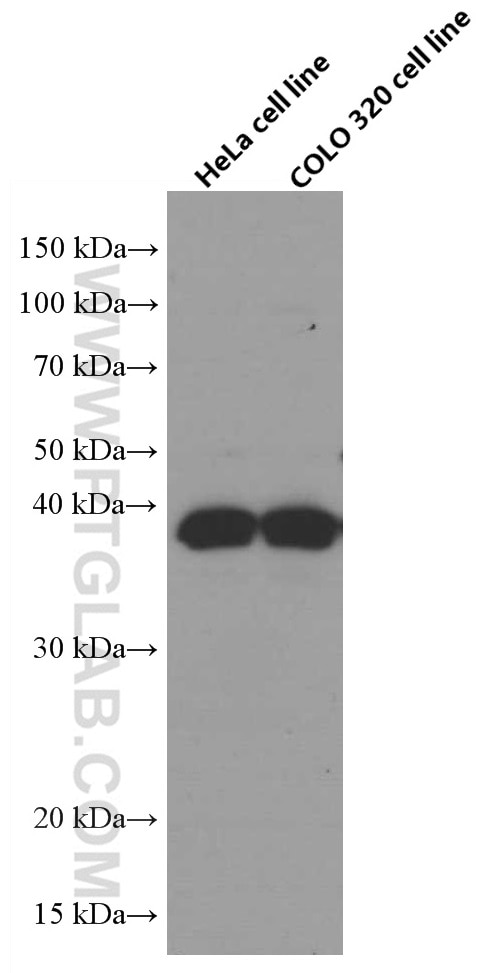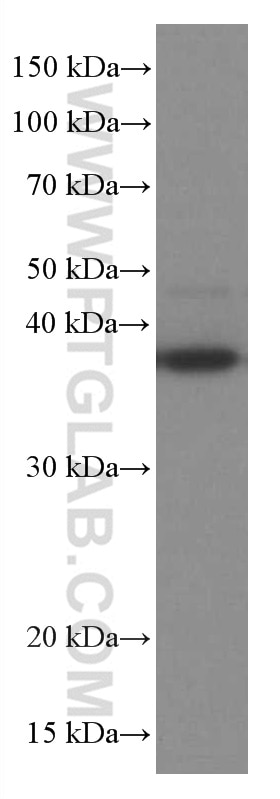- Phare
- Validé par KD/KO
Anticorps Monoclonal anti-TNFSF11/RANKL
TNFSF11/RANKL Monoclonal Antibody for WB, IF/ICC, ELISA
Hôte / Isotype
Mouse / IgG1
Réactivité testée
Humain, rat, souris
Applications
WB, IHC, IF/ICC, ELISA
Conjugaison
Non conjugué
CloneNo.
3F2E1
N° de cat : 66610-1-Ig
Synonymes
Galerie de données de validation
Applications testées
| Résultats positifs en WB | cellules COLO 320, cellules DC2.4, cellules HeLa, cellules HUVEC, cellules JAR, cellules NCCIT, cellules RAW 264.7, cellules U2OS, tissu splénique humain |
| Résultats positifs en IF/ICC | cellules MCF-7, |
Dilution recommandée
| Application | Dilution |
|---|---|
| Western Blot (WB) | WB : 1:2000-1:10000 |
| Immunofluorescence (IF)/ICC | IF/ICC : 1:400-1:1600 |
| It is recommended that this reagent should be titrated in each testing system to obtain optimal results. | |
| Sample-dependent, check data in validation data gallery | |
Applications publiées
| WB | See 9 publications below |
| IHC | See 4 publications below |
| IF | See 4 publications below |
Informations sur le produit
66610-1-Ig cible TNFSF11/RANKL dans les applications de WB, IHC, IF/ICC, ELISA et montre une réactivité avec des échantillons Humain, rat, souris
| Réactivité | Humain, rat, souris |
| Réactivité citée | rat, Humain, souris |
| Hôte / Isotype | Mouse / IgG1 |
| Clonalité | Monoclonal |
| Type | Anticorps |
| Immunogène | TNFSF11/RANKL Protéine recombinante Ag19975 |
| Nom complet | tumor necrosis factor (ligand) superfamily, member 11 |
| Masse moléculaire calculée | 317 aa, 35 kDa |
| Poids moléculaire observé | 35-38 kDa |
| Numéro d’acquisition GenBank | BC074890 |
| Symbole du gène | RANKL |
| Identification du gène (NCBI) | 8600 |
| Conjugaison | Non conjugué |
| Forme | Liquide |
| Méthode de purification | Purification par protéine G |
| Tampon de stockage | PBS with 0.02% sodium azide and 50% glycerol |
| Conditions de stockage | Stocker à -20°C. Stable pendant un an après l'expédition. L'aliquotage n'est pas nécessaire pour le stockage à -20oC Les 20ul contiennent 0,1% de BSA. |
Informations générales
TNFSF11 also known as RANKL, is a member of the tumor necrosis factor (TNF) cytokine family which is a ligand for osteoprotegerin and functions as a key factor for osteoclast differentiation and activation. RANKL is a polypeptide of 217 amino acids that exerts its biological activity both in a transmembrane form of about 40-45 kDa and in soluble one of 31 kDa (PMID: 15308315). The membrane-bound RANKL (mRANKL) is cleaved into a sRANKL by the metalloprotease-disintegrin TNF-alpha convertase (TACE) or a related metalloprotease (MP). RANKL induces osteoclast formation through its receptor, RANK, which transduces signals by recruiting adaptor molecules, such as the TNF receptor-associated factor (TRAF) family of proteins. RANKL was shown to be a dentritic cell survival factor and is involved in the regulation of T cell-dependent immune response. T cell activation was reported to induce expression of this gene and lead to an increase of osteoclastogenesis and bone loss. RANKL was shown to activate antiapoptotic kinase AKT/PKB through a signaling complex involving SRC kinase and tumor necrosis factor receptor-associated factor (TRAF) 6, which indicated this protein may have a role in the regulation of cell apoptosis.
Protocole
| Product Specific Protocols | |
|---|---|
| WB protocol for TNFSF11/RANKL antibody 66610-1-Ig | Download protocol |
| IF protocol for TNFSF11/RANKL antibody 66610-1-Ig | Download protocol |
| Standard Protocols | |
|---|---|
| Click here to view our Standard Protocols |
Publications
| Species | Application | Title |
|---|---|---|
J Cancer Gut microbiota deficiency ameliorates multiple myeloma and myeloma-related bone disease by Th17 cells in mice models | ||
Folia Histochem Cytobiol Platelet-rich plasma ameliorates cartilage degradation in rat models of osteoarthritis via the OPG/RANKL/RANK system | ||
Cell Death Dis RANK promotes colorectal cancer migration and invasion by activating the Ca2+-calcineurin/NFATC1-ACP5 axis. | ||
Open Life Sci Effect of periostin on bone metabolic and autophagy factors during tooth eruption in mice | ||
Adv Healthc Mater Structured Polymers Enable the Sustained Delivery of Glucocorticoids within the Intra-Articular Space | ||
Poult Sci Zinc Glycine supplementation improves bone quality in meat geese by modulating gut microbiota, SCFA's, and gut barrier function through Wnt10b/NF-κB axis |

